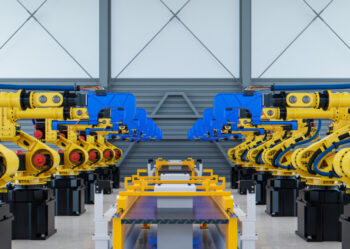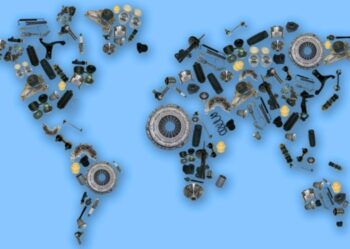How power electronics represent the real challenge of the electric vehicle?

While the pressure is growing on manufacturers with the end of the thermal vehicle, the subject of batteries and tensions on some materials are growing.
After Covid-19, which triggered the shortage of semiconductors,, and after the increase in raw materials, logistics and energy costs, , another issue must be taken into account in the production of electric vehicles, and that is power electronics.
What are power electronics, what are they used for and why are they important for electric vehicles?
Definition of power electronics :
In an electric vehicle, there are more electronic components than in a combustion model.
Power electronics is one of the branches of electrical engineering that deals with devices (converters) that change the form of electrical energy.
It includes the study, the realization and the maintenance :
- electronic components used in high power
- structures of converters
- the control of these converters
- industrial applications of these converters
Power electronics occupies an increasingly important place in the automotive industry and more particularly for the electric vehicle.
It is the key element of the traction inverter, the DC/DC converter for the on-board network and the battery charger.
Use and challenges of power electronics
Where to find the power electronics in the electric vehicle:
The power electronics essential for inverters, DC/DC power converters and battery chargers play a key role in motor control, energy management (whether for driving or braking) as well as in charging speed.
The challenges of New Power Electronics are :
- Significant cost reduction
- Increasing the compactness of the volume
- More efficient cooling
France & power electronics :
France would have enough assets to capture this market on a European scale by 2030, according to a conference organized by the Federation of Electrical, Electronic and Communication Industries (FIEEC.)
Indeed, power electronics is one of the skills that France is fortunate to have in both the public and private sectors. With 35 research laboratories (with more than 800 researchers) and 24 R&D centers working on this theme, France could capture a quarter of the power electronics market.
Moreover, the various laboratories and research centers are working on new components based on silicon carbide and gallium nitrate. These should help reduce the size of components while allowing a higher voltage.
In 2020, the electronics industry (ACSIEL) and the automotive industry (PFA, FIEV, SIA, competitiveness clusters) decided to work together to build a French power electronics team. The ambition was simple and common: to make France a world leader in power electronics.
The “Power Electronics” program, created in June 2020, aims to preserve France’s capacity for innovation and to respond to the major changes in the automotive sector, in a context where the economic crisis is leading all players to adopt cost-saving measures, particularly in R&D. As part of the 4th Investment Program for the Future (2021-2025), more than 15 million euros have been committed as of 2020 and allocated to the power electronics R&D program led by national automakers (Renault, Stellantis), equipment manufacturers (Valeo, Vitesco) and semiconductor manufacturers (STMicroelectronics, Soitec).
French government implicated
To go further, and given the shortage of semiconductors and the increase in material prices, the French government presented its investment plan for electronics on July 12, as part of France 2030. The program includes the development of the industrial sector, research and innovation, and support for training.
This is the objective of the strategy for electronics carried by France 2030 and unveiled on July 12, 2022.
In total, more than 5 billion euros have been earmarked in France 2030 for the development and industrialization of electronic technologies. This budget should help meet the needs of French industries in the context of digital and ecological transitions, around three main areas:
The development of production capacities and the industrialization of innovative technologies:
Avoiding supply tensions in components that directly affect French companies. This is the situation that the Government wishes to block at all costs. To face this problem, the strategy for electronics proposes to support the industrialization of electronic technologies in France and, more globally, to aim for an increase in production capacity of around 90% by 2026-2027.
Research and innovation to prepare for the next breakthroughs:
Through France 2030, the Government wishes to support innovation and exploratory research in the electronics manufacturing sector. The goal is to increase the potential of electronic technologies that will help meet the various objectives of France 2030. Among these, for example, the objectives of ecological transition, which require considerable gains in performance and sobriety of electronic systems.
Support for training and skills development:
While the French electronics industry is growing rapidly and should see an increased need for recruitment in the coming years, at all levels of training, it is currently struggling to recruit. It suffers, moreover, from a lack of visibility and attractiveness to young people. The strategy for electronics aims to support the increase of training capacities to accompany the needs in skills in the whole sector. 50 million euros will be devoted to support projects for the development of training and skills
In concrete terms, what are automotive manufacturers doing?
Valeo and CEA cooperate in advanced research
Valeo, the French automotive supplier, and the CEA (Commissariat à l’Energie Atomique: a major research player specializing in the energy transition, among other things) are cooperating to conduct advanced research on innovative electronic technologies.
The aim is to improve the autonomy of electric vehicles, optimize the powertrain and reduce the weight of on-board power electronics.
This cooperation will enable Valeo to share its experience in electrification with the CEA, while the CEA will be able to contribute its knowledge in microelectronics and materials, as well as in digital technology, in order to simulate and optimize the conversion systems.
French carmaker Renault joins forces with German Vitesco
Renault has teamed up with Vitesco to develop a unique power electronics concept in the form of a single box (“One Box”)
The objective is to create an electronic unit that combines all components: the DC-DC converter, the on-board charger and the inverter. This concept will result in a significant gain in compactness (-45% in terms of volume), thereby reducing the mass of the vehicle.
As a result, Renault’s future electrified vehicles will be able to offer more roominess and comfort for passengers. The configurations and assembly of the various basic components will be adapted to the types of engines (electric or hybrid). It should be noted that the development of this “One Box” is planned from 2026.
In addition, Vitesco Technologies will supply Renault with a “High Voltage Box”, which will combine the DC/DC converter and the charger, for battery electric vehicles from 2025.
This is an opportunity for Renault to strengthen its control of the electric value chain and to further anchor technological and industrial developments for electric vehicles in France.
Sef Power acquires its compatriot CNB Electronique
Thanks to this acquisition, SEF Power is working towards a growth strategy in power electronics.
SEF Power, an SME specializing in the development and manufacture of critical equipment for railway maintenance and the supply of coupling harnesses for the automotive industry, has acquired CNB Electronique, a French manufacturer of high-performance, high-power switching and linear power supplies intended mainly for the defense and research markets.
However, the resulting group has intentions. These intentions involve offering design and production services for electronic systems. These services are tailored for demanding environments. The group achieves this through its teams of design and production, which are based in France. The production includes capabilities in SMD, through-hole, and wired technologies. They also provide testing and customer support services. All operations are conducted according to ISO9001 and EN9100 standards.
ACTIA, ALL CIRCUITS AND LACROIX unite on an assembly technology project for power electronics
Actia, All Circuits, and Lacroix are the three main French electronic subcontractors. They are positioned on the automotive market. These companies have joined forces to launch the PREMS (PoweR Electronic Manufacturing Services) project. The goal of this project is to accelerate the manufacturing in France of power electronics. Specifically, it aims to support the production for the next generation of electric vehicles.
With a budget of €2.25 million, PREMS is adequately funded. The budget is shared equally between the project partners. PREMS receives support from the Power Electronics program. Additionally, it benefits from France Relance funding.
The coordination and steering of the project are entrusted to the “We Network Technical Center.” This center has been leading cooperation projects in the electronics assembly industry in France. It has been operating in Angers since 2016.
The PREMS program
The PREMS program focuses on the assembly, control and testing processes of these new power functions. Over a period of three years, PREMS will operate. It will focus on projects linked to the progress of R&D work in the automotive industry. PREMS aims to provide the automotive industry in France with production know-how by 2024. This know-how is crucial to support the expected rise in the volume of electric vehicles between 2025 and 2030.
“The stakes involved in the development of the electric vehicle for the electronics industry go beyond the capacity of individual players to respond. Cooperation between the main leaders in automotive electronics subcontracting is crucial. This collaboration is necessary to accelerate our response to a major challenge for Made in France”. These sentiments were explained by Arnaud Nicolas, R&D director of the All Circuits group, in an interview.
“Power electronics is spreading to a wide variety of sectors. The cooperation approach implemented through PREMS for the automotive market can be applied in other areas (transportation, energy, industry) with the players present in these markets to go further together and improve the resilience of the entire industry,” added Benjamin Gauchenot, Vice President Quality & Operation at Lacroix Electronics, in an interview
A global approach for the future
The ambition of the 2030 electronics plan is clear. It aims to develop components that consume less energy. Additionally, it seeks to reduce reliance on rare earths.
In this way, ST’s future 10-nanometer semiconductors will be four times more powerful. They will also require four times less energy. This efficiency will enable them to handle other functions effectively.
Tomorrow’s chips will support computing power, new sensors and will take into account new communication modes (5 G, 6 G).
It is clear that the automotive industry will play a significant role. It will serve as one of the main outlets for these innovations. These innovations pertain to new electrical and electronic architectures. The French electronics industry is experiencing growth. It is preparing to undergo a significant increase in recruitment and training at all levels. This anticipation is driven by the emergence of new business associations.
However, the sector is not a dream and is struggling to recruit.
This is why the PFA (Plateforme de la Filière Automobile) is taking action. They are well aware of the problem of the attractiveness of the power electronics sector. Additionally, they recognize challenges within the automotive industry as a whole. The PFA is actively working on addressing this subject.
SNECI and its support
A Tech Show dedicated to power electronics is being organized on October 11 at Centrale Supélec. Engineering students and recent graduates will have the opportunity to attend. They will have the chance to meet a large number of players recruiting in this field. These players include companies such as SNECI, Stellantis, Renault, ST Microelectronics, Valeo, Vitesco, Schneider Electric, Safran, etc.
SNECI, 70 years of excellence in improving industrial and commercial performance on an international scale with 10 subsidiaries, is already working with power electronics players, including Chinese suppliers producing high-voltage systems such as flexible busbars, engine controllers, load cells and devices, etc.





